This is the best cheesecake recipe for two reasons– it has a perfectly smooth texture without being too dense, and you don’t need a water bath to bake a velvety, crack-free cheesecake! I know it might seem a bit odd to bake a cheesecake without a water bath, but with a few easy tricks, you just don’t need to fuss with boiling water and the risk of water leaking into the pan, forming a soggy crust.
This tangy, creamy homemade cheesecake is perfect for any occasion, from birthdays to holiday dinners to a random night when you just need a delicious slice or two of rich cheesecake. With well-balanced flavors from simple ingredients, an addictively silky filling, and a crisp graham cracker crust, this easy cheesecake recipe will disappear in no time. For more cheesecake recipes, try one of my tried and true recipes, like my blueberry cheesecake recipe, chocolate cheesecake recipe, and Oreo cheesecake recipe!
What You Need To Make This Recipe
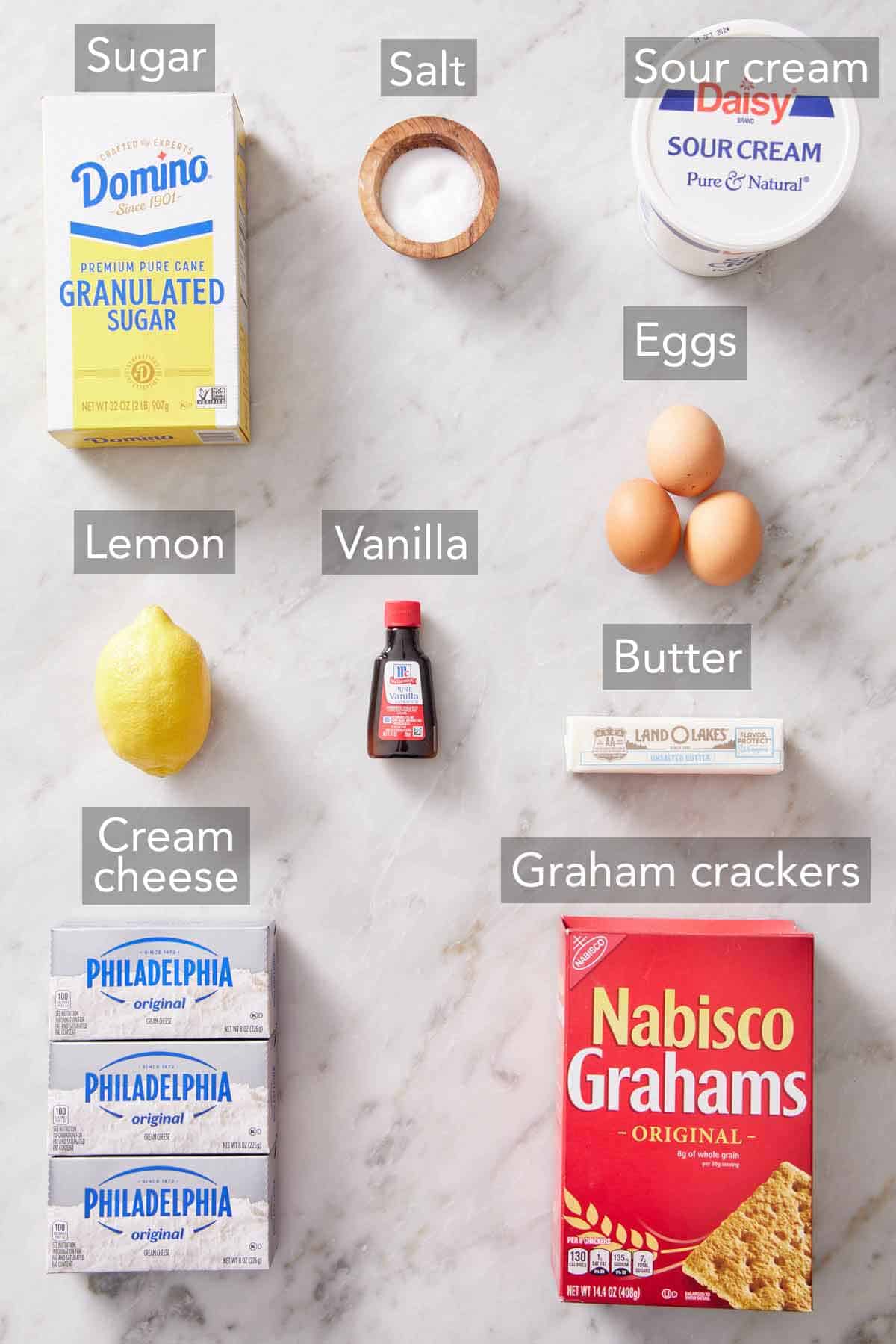
Graham cracker crust — for the buttery, crisp crust, you need graham cracker crumbs, melted butter, and sugar. You can buy premade crumbs in a box at the grocery store or blitz your own graham crackers in a food processor. Check out my graham cracker crust recipe for all the tips you need to know to make the perfect crust.
Cream cheese — blocks of plain, full-fat cream cheese is the best option. Low-fat cream cheese contains more water and can produce a cheesecake with an extra dense or grainy texture.
Granulated Sugar — you need 1 cup of white sugar to sweeten the cheesecake filling.
Vanilla — use high-quality vanilla extract, not vanilla essence. If you prefer a bakery-style look with little vanilla flecks in the batter, you can scrap the seeds from a vanilla bean or use vanilla bean paste.
Lemon juice — a little lemon juice cuts through the richness of the filling. This addition won’t taste like a lemon cheesecake, but it does enhance the flavor of the filling making it extra delicious!
Eggs — bring the eggs to room temperature before you start working on this recipe. If the eggs are cold, the cream cheese can firm back up when mixed with the eggs and form lumps in the batter.
Sour cream — use full-fat sour cream for the best results. Just like the eggs, let it come to room temperature for 30 minutes to 1 hour before you start the recipe.
What’s The Best Cream Cheese To Use?
For the best cheesecake ever, make sure you use the brick-style cream cheese, not the spreadable kind that comes in a carton. It should be plain and full-fat for the best flavor and perfect creamy texture. I prefer Philadelphia brand cream cheese. Other brands or generic store blocks can also work well, but the flavor and moisture content varies between each, so I always use Philadelphia to ensure consistent, delicious results.
Be sure to set it out for at least two hours before you start working on this recipe so the cream cheese has plenty of time to soften. This makes it easier to incorporate into a smooth, silky filling. Need to soften it faster? The warm bowl trick that I share for how to soften butter works really well here, too!
How To Make The Best Cheesecake
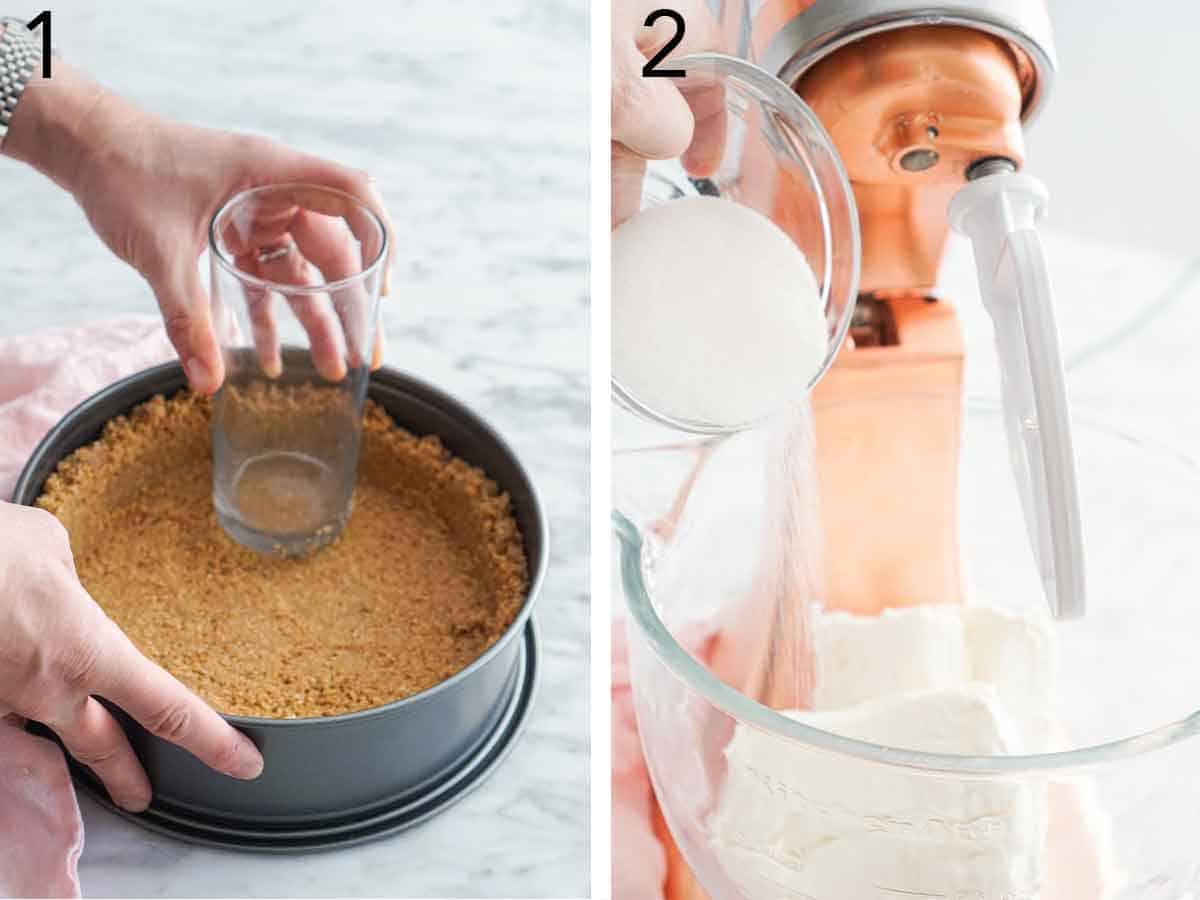
1. Make the buttery graham cracker crust in a medium bowl by combining the graham cracker crumbs, melted butter, and sugar. Stir together until the mixture feels like wet sand. Pour into a 9-inch springform pan. Press the crumbs into the bottom and slightly up the sides of the pan using the bottom of a glass or measuring cup. Place on a baking sheet and bake at 350°F for 10 minutes. Remove from the oven and let cool while making the cheesecake filling.
2. Place the cream cheese in a large bowl or the bowl of a stand mixer with the whip attachment. Beat on medium-low speed until creamy and smooth. Add the sugar, salt, vanilla extract, and lemon juice. Beat until the mixture is well combined and completely smooth. Stop and scrape down the sides of the bowl a few times during mixing to ensure everything is well incorporated.
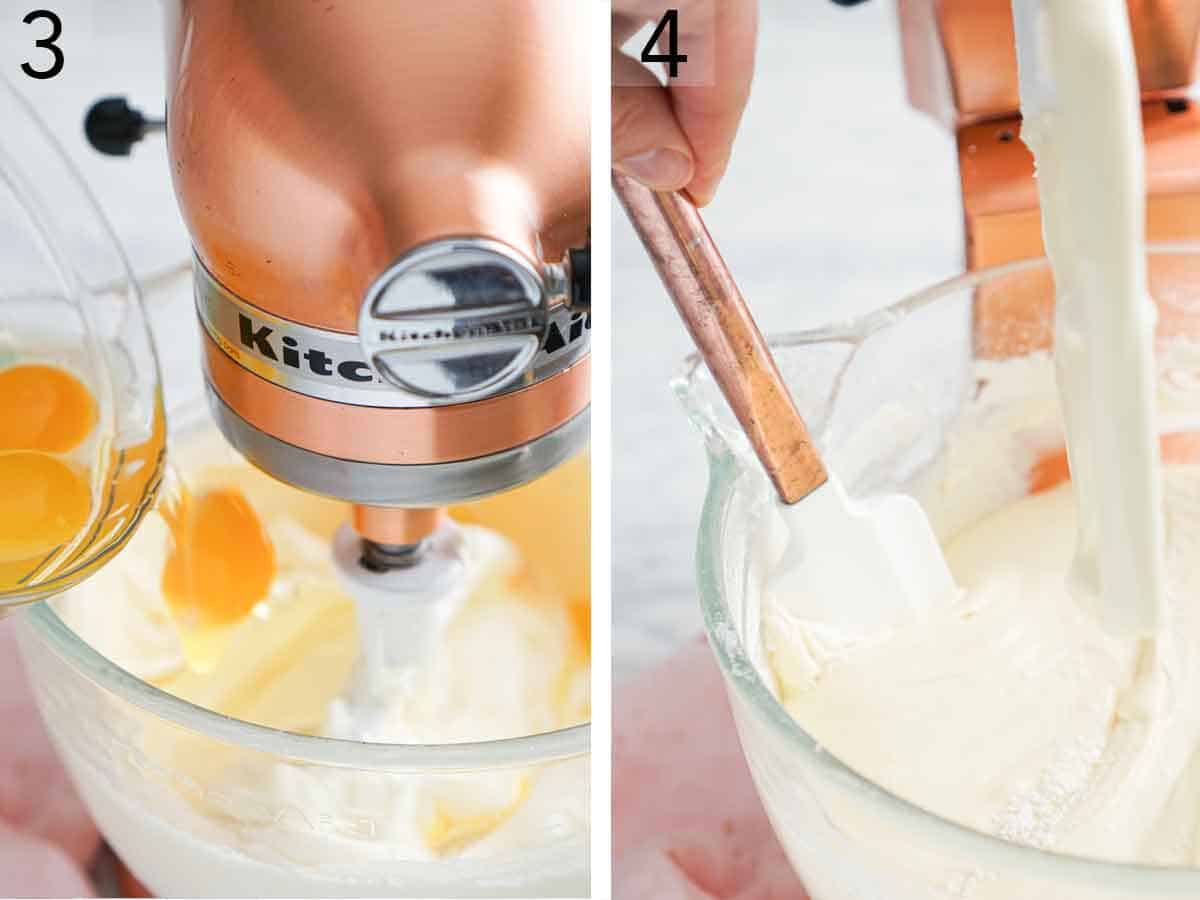
3. With the mixer on medium-low speed, add the eggs one at a time.
4. Stop and scrape down the bowl between additions.
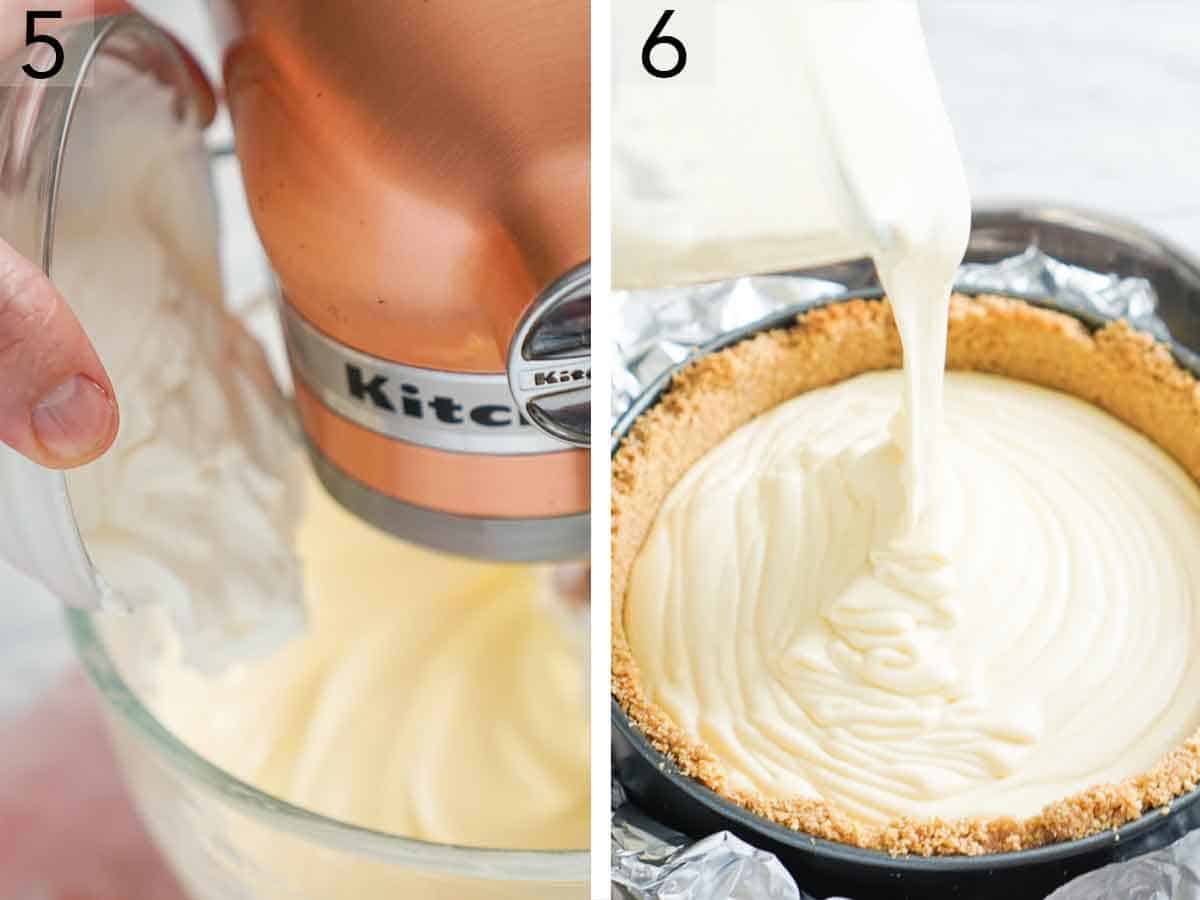
5. Once the eggs are well combined, mix in the sour cream until well incorporated.
6. Pour the batter into the cooled crust. Bake for 15 minutes, then reduce the oven temperature to 300°F and continue baking for another 30 to 35 minutes or until the edges of the filling are just slightly puffed and the center wobbles slightly when shaken gently. Turn off the oven and leave it in there with the door closed for 1 hour. Remove the cheesecake and let it cool at room temperature for another hour, then chill it in the refrigerator for at least 6 hours or up to 3 days before serving.
How To Prevent Your Cheesecake From Cracking
Follow these easy tips to bake up the perfect cheesecake:
- Use room temperature ingredients. Make sure to bring your cold ingredients (eggs, sour cream, and cream cheese) to room temperature so they will easily incorporate without overmixing.
- Don’t over-mix the batter. Over-mixing will incorporate too much air into the batter, leading to the cheesecake to puff up too much in the oven and then fall when it cools, giving you a cracked surface.
- Don’t open the oven! Do not open the oven to peek once the oven has been turned off to let the cheesecake cool. The hot air from the oven will escape, and cold air will enter the oven, causing the cheesecake to fall or crack. Abrupt temperature changes are a big reason cheesecake fillings crack, so avoid them as much as possible.
- Cool it slowly. Start by cooling the cheesecake in the oven and then at room temperature before eventually transferring it to the fridge to chill. The gradual cooling process prevents it from cracking.
Why You Don’t Need A Water Bath
Cheesecakes have a reputation for being fussy to bake, and one of the main reasons for this is the water bath. I specifically developed this recipe so that you can bake a cheesecake with a smooth, crack-free surface without a water bath! Here are my secrets to why you don’t have to use one for my recipe:
- Using the right number of eggs. The correct ratio of eggs to cream cheese is vital for a smooth surface and a filling that is dense but still fluffy. Too many eggs will cause the filling to puff up too much, then collapse and crack when it cools. Too few, and the cheesecake will be too dense and crack when it cools. Generally, you want to use 1 large egg per 1 (8-ounce) block of cream cheese.
- Baking slowly at a lower temperature. This allows the filling to set slowly, resulting in the ideal crack-free surface because the filling cooks more evenly. Although the filling will puff some, it doesn’t dramatically puff on the edges and overbake before the center is done.
- Don’t trust your oven? If you’re concerned that your oven may run or cycle hotter than the intended bake temperature, you can put a casserole dish of hot water on the bottom oven rack with your cheesecake on the rack above it. This will add extra moisture to the oven without placing your pan in the water and risking water seeping into your cheesecake crust.
Why You Do Need A Springform Pan
A springform pan is a must for a baked cheesecake because it makes serving so easy. Since you can’t invert a cheesecake from a cake pan to remove it like you can, for example, a classic vanilla cake, a springform pan allows you to simply remove the sides of the pan and slide the cheesecake onto a serving dish.
In a pinch, you could bake this in a 10-inch pie dish and simply serve it out of the dish. The overall baking time might be 10 to 15 minutes less since the cheesecake will be a bit thinner.
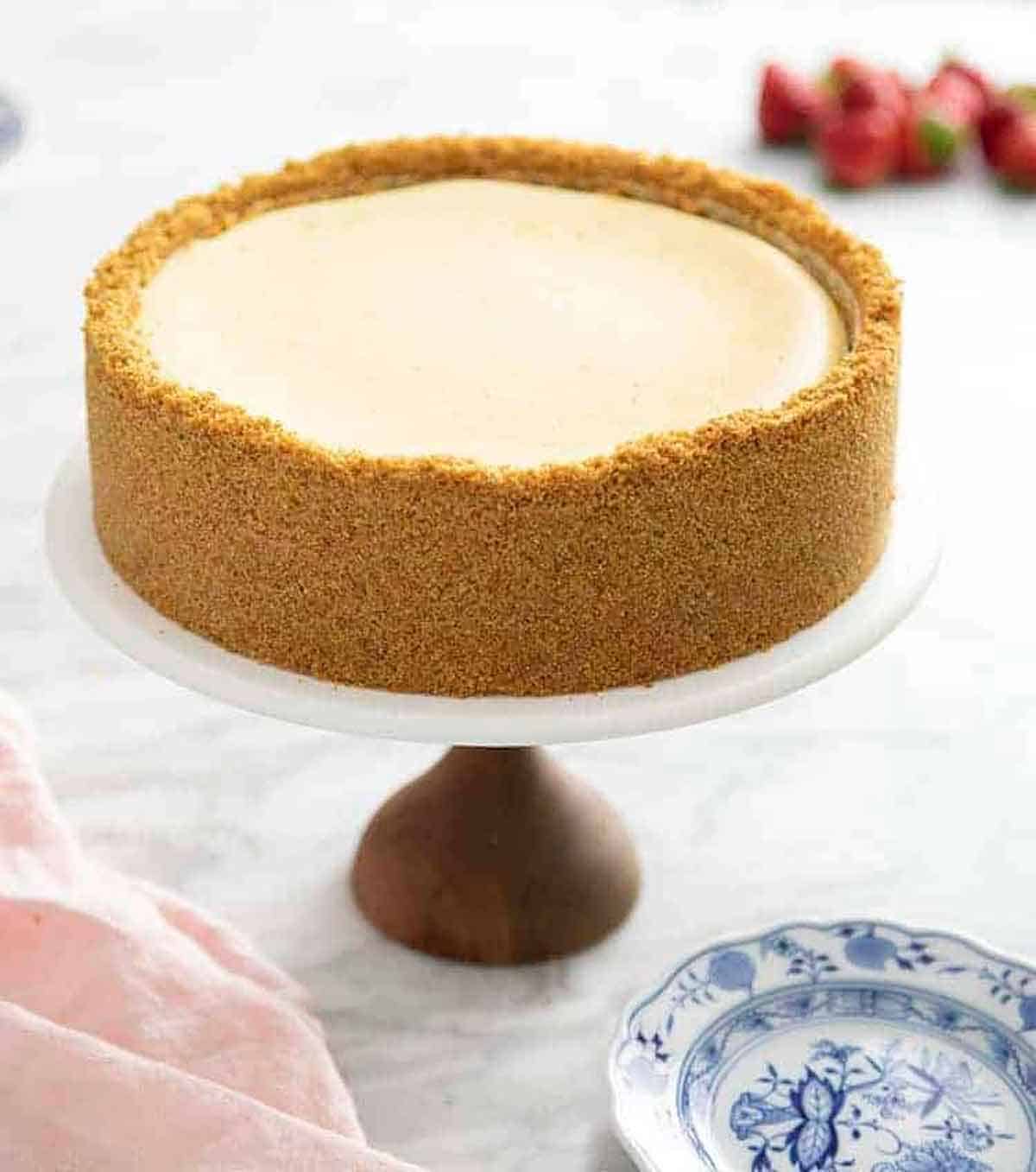
Topping and Serving ideas
This cheesecake recipe is the perfect palette for your favorite toppings. Here are some of my favorites to serve over a cheesecake slice:
- Cherry pie filling
- Lemon curd
- Chocolate ganache
- Caramel sauce
- Homemade whipped cream
- Fresh fruit
- Fruit sauces like strawberry or raspberry sauce. Try my strawberry cheesecake for a chunky, glossy strawberry sauce topping.
How to Store
Make-ahead: Since cheesecake keeps well in the refrigerator for up to 4 days, feel free to make it a night or two in advance. This is actually the perfect way to ensure it has plenty of time to chill in the refrigerator. I like to keep it in the springform pan, lay a thin tea towel or paper towel on the top edge of the pan, and then wrap it with foil or plastic wrap. The towel will absorb any moisture and keep it from dripping onto the cheesecake filling. Remove it from the pan when you are ready to serve.
Leftovers: Store the cheesecake in an airtight container and refrigerate for up to 4 days.
Pro Tips For Making This Recipe
- Use the whisk attachment for the mixer. Many cheesecake recipes call for using a paddle attachment when beating the filling together. I used to do the same, but it was easy to find little lumps of cream cheese even when scraping down the bowl many times during mixing. I found that the whisk actually helps incorporate all of the ingredients more thoroughly! Just don’t increase the mixer speed above medium-low to avoid incorporating too much air.
- If your springform pan is not nonstick: You can lightly spray it with baking spray or rub the pan very lightly with oil before pressing in the crust mixture.
- Remove air bubbles: When you pour the batter into the pan, gently tap the cheesecake on the counter to pop any air bubbles in the batter.
- Use an offset spatula: It is a great tool for this recipe as it helps get the top of the cheesecake super smooth before baking.
- Let the cheesecake cool gradually. Don’t place it directly into the fridge to speed up the process, or it can easily crack.
- For perfect slices: Warm a sharp knife with hot water for a few seconds, then dry it. Wipe off the knife between slices and rewarm it as needed.
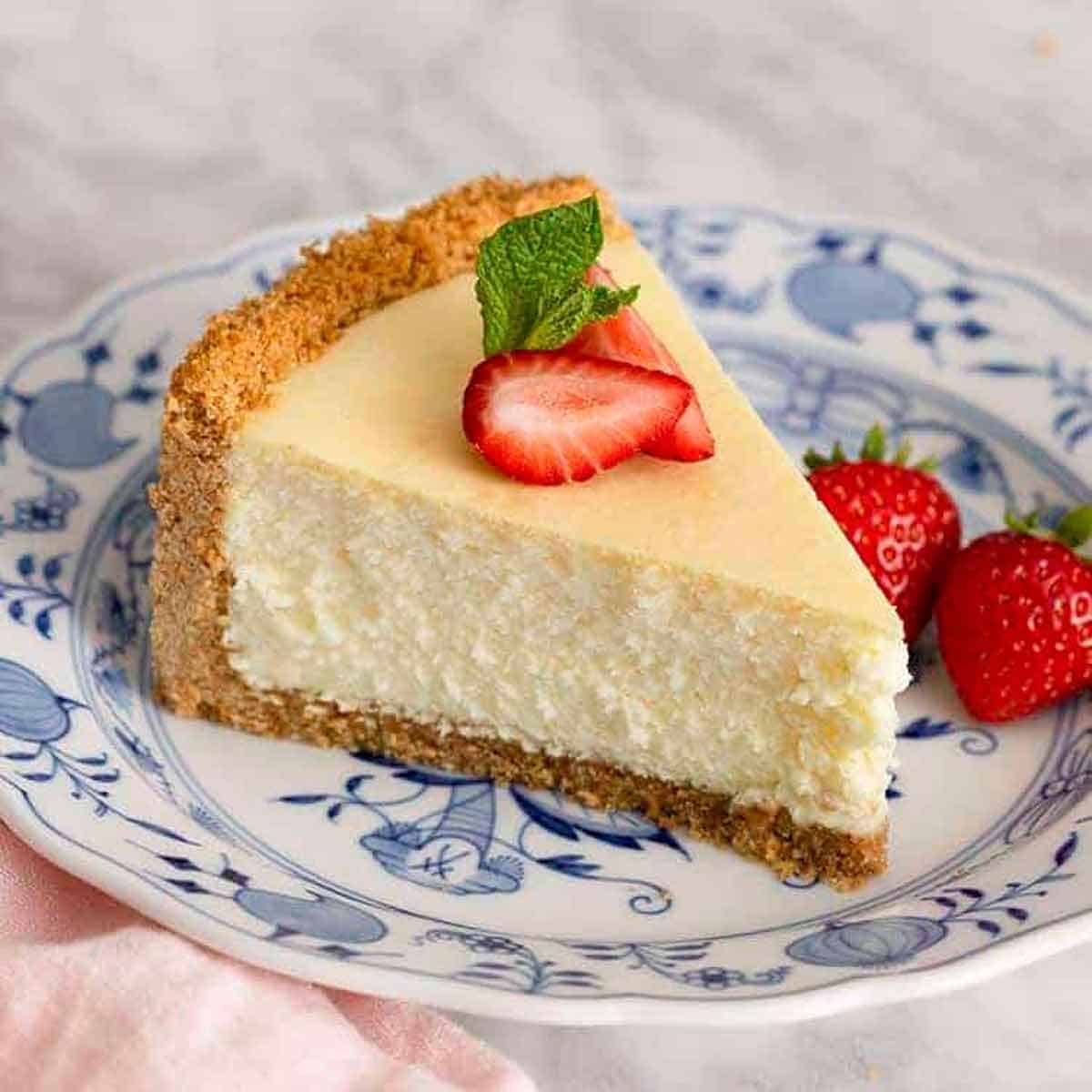
Frequently Asked Questions
You can swap the graham crackers for vanilla wafers, Biscoff cookies, or digestive biscuits. For a chocolatey twist, use my Oreo pie crust recipe instead of the graham cracker crust.
Making a crustless cheesecake requires a few specific tweaks. Line the springform pan with parchment paper as directed in my Basque cheesecake recipe, or bake that recipe for a delicious crustless cheesecake!
Yes! Cheesecake freezes very well. You can either freeze the whole cheesecake or individual slices.
To freeze the whole cheesecake: Leave it in the pan, wrap the pan tightly in a few layers of plastic wrap and aluminum foil, and freeze for up to 3 months. Thaw in the refrigerator overnight or at room temperature for 4 hours before serving.
To freeze individual slices: Wrap each slice in plastic wrap and foil and place in a freezer bag or freezer-safe container for up to 3 months. Thaw in the refrigerator for a few hours or at room temperature for 1 hour before digging in.
If you’ve tried this cheesecake recipe, then don’t forget to rate it and let me know how you got on in the comments below. I love hearing from you!
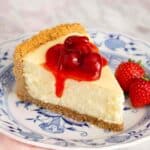
Cheesecake Recipe
Video
Equipment
- Electric or stand mixer
- mixing bowl
- 9 inch springform pan
- Baking Sheet
Ingredients
For the Crust
- 1½ cups graham cracker crumbs (180g)
- ¼ cup unsalted butter melted
- 2 tablespoons granulated sugar
For the Filling:
- 3 (8-ounce/227g) blocks cream cheese room temperature
- 1 cup granulated sugar (200g)
- ¼ teaspoon salt
- 2 teaspoons vanilla extract (10mL)
- 1 teaspoon lemon juice
- 3 large eggs room temperature
- ½ cup sour cream room temperature (120g)
Instructions
For the Crust:
- Preheat the oven to 350F.
- In a medium bowl, combine the cracker crumbs, melted butter, and sugar. Stir together until the mixture feels like wet sand. Pour into a 9-inch springform pan. (If your pan isn’t non-stick, you can lightly spray it with baking spray before adding the crumb mixture.) Press the crumbs into the bottom and slightly up the sides of the pan using the bottom of a glass or measuring cup. Place on a baking sheet.
- Bake for 10 minutes. Remove from the oven and let cool while making the filling.
For the Filling:
- Place the cream cheese in a large mixing bowl or the bowl of a stand mixer with the whip attachment. Beat on medium-low speed until creamy and smooth, about 1 minute. Add the sugar, salt, vanilla, and lemon juice. Beat until the mixture is well combined and completely smooth. Stop and scrape down the bowl a few times during mixing.
- With the mixer on medium-low speed, add in the eggs one at a time. Stop and scrape down the bowl between additions. Once the eggs are well combined, mix in the sour cream until well incorporated. Pour the batter into the cooled crust.
- Bake for 15 minutes. Reduce the oven temperature to 300F and continue baking for another 30 to 35 minutes or until the edges of the filling are just slightly puffed and the center wobbles slightly when gently shaken.
- Turn off the oven and leave the cheesecake in the oven with the door closed for 1 hour. Remove the cheesecake and let cool at room temperature for another hour, then chill for at least 6 hours or up to 3 days before serving. (If refrigerating for several days, loosely cover after the cheesecake is fully chilled.)
Notes
- Use the whisk attachment for the mixer. Many cheesecake recipes call for using a paddle attachment when beating the filling together. I used to do the same, but it was easy to find little lumps of cream cheese even when scraping down the bowl many times during mixing. I found that the whisk actually helps incorporate all of the ingredients more thoroughly! Just don’t increase the mixer speed above medium-low to avoid incorporating too much air.
- If your springform pan is not nonstick: You can lightly spray it with baking spray or rub the pan very lightly with oil before pressing in the crust mixture.
- Remove air bubbles: When you pour the batter into the pan, gently tap the cheesecake on the counter to pop any air bubbles in the batter.
- Use an offset spatula: It is a great tool for this recipe as it helps get the top of the cheesecake super smooth before baking.
- Let the cheesecake cool gradually. Don’t place it directly into the fridge to speed up the process, or it can easily crack.
- For perfect slices: Warm a sharp knife with hot water for a few seconds, then dry it. Wipe off the knife between slices and rewarm it as needed.



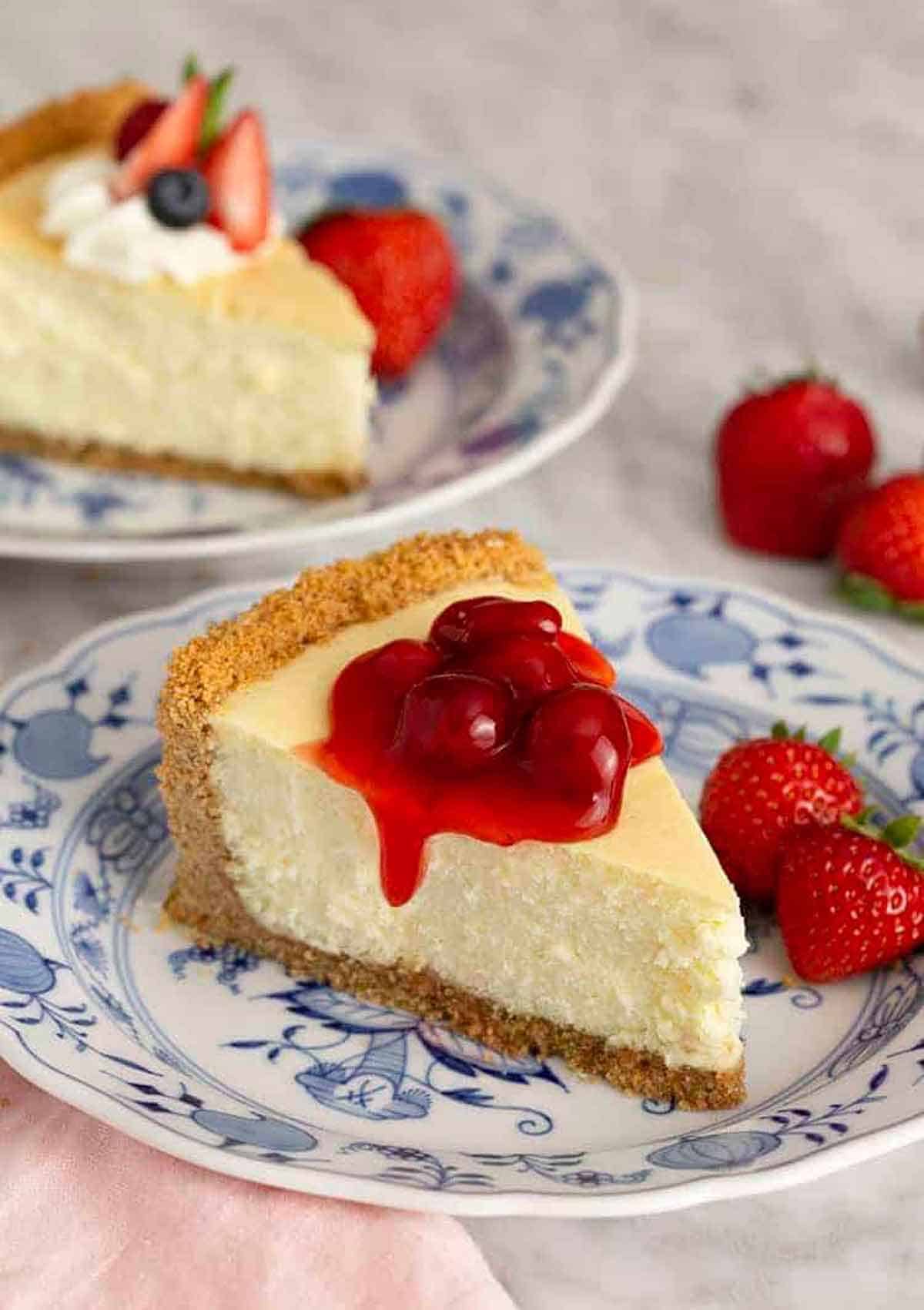
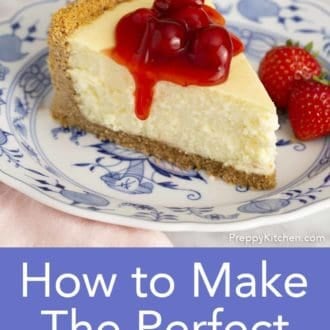
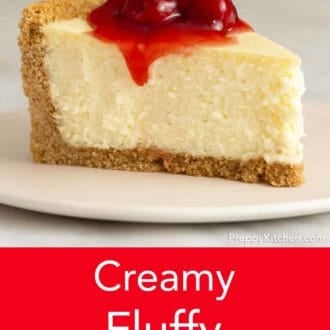
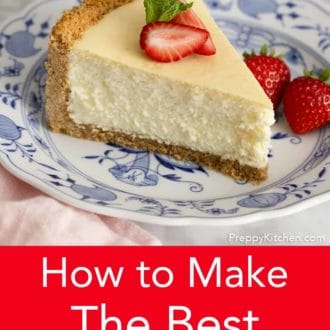
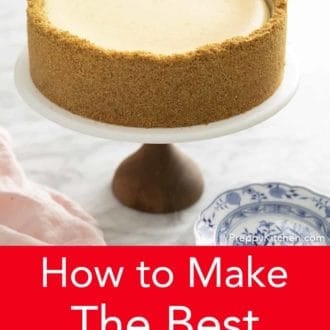
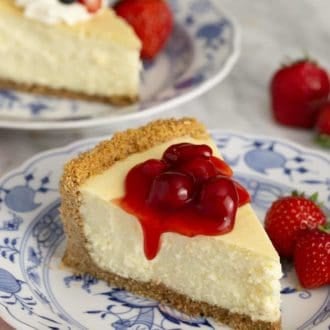
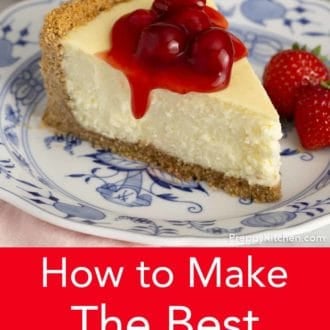

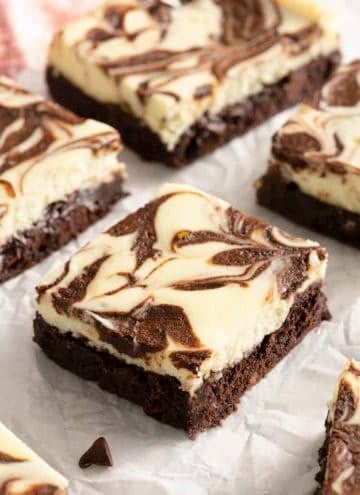
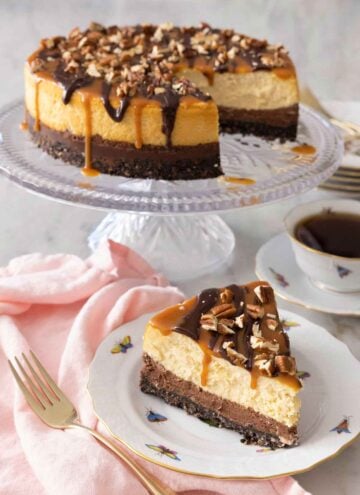
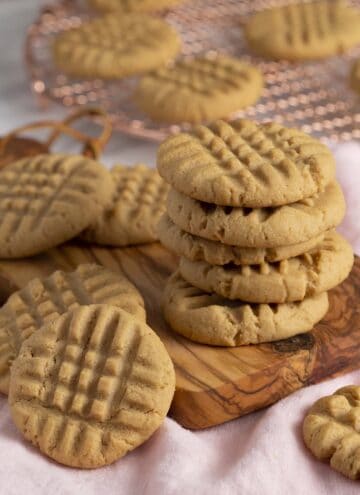

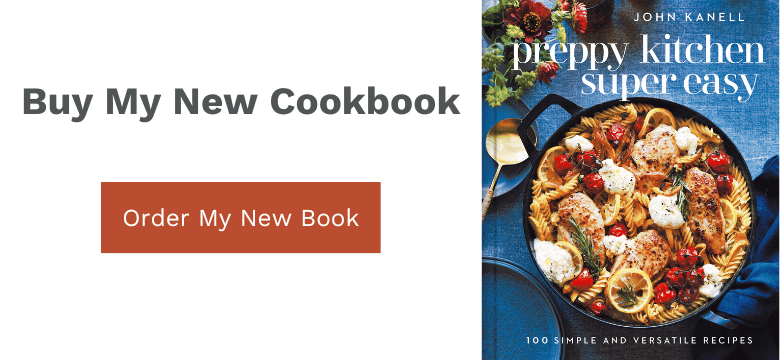
Christine Defilippo says
It came out perfect…. It was quite easy to make as well.
Kim says
Do I cool in refrigerator in the pan before opening sides
Sarah Ward (Executive Editor, Preppy Kitchen) says
Yes, remove it from the pan when you are ready to serve. Chilling it in the pan keeps it secure so you don’t accidentally bump it in the fridge and crack the crust.
Nicole says
Best cheesecake ever! It lives up to the no cracking, perfect every time. The texture is amazing, I would definitely recommend trying this one!
Maggie says
I made for Mother’s Day, everyone loved it, I didn’t taste it because it was gone, I’m going to make it again this weekend.
Thank you for the fabulous recipe 😋
Maggie.
Brittany says
I made this for my coworkers a couple weeks ago and they were over the moon!!! I added an extra tablespoons of flour cause I’m high altitude, but it’s AMAZING!!! Highly recommended!!!
Michele Lawson says
This was the most delicious cheesecake and it was so easy to follow the instructions! Thank you so much for sharing! Our family said it was the best cheesecake they have ever eaten and I agree. Creamy, fluffy and delicious